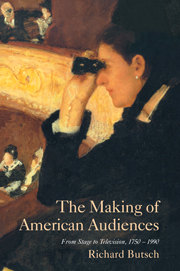Book contents
- Frontmatter
- Contents
- Acknowledgments
- Introduction: Participative Public, Passive Private?
- 1 Colonial Theater, Privileged Audiences
- 2 Drama in Early Republic Audiences
- 3 The B'Hoys in Jacksonian Theaters
- 4 Knowledge and the Decline of Audience Sovereignty
- 5 Matinee Ladies: Re-gendering Theater Audiences
- 6 Blackface, Whiteface
- 7 Variety, Liquor, and Lust
- 8 Vaudeville, Incorporated
- 9 “Legitimate” and “Illegitimate” Theater around the Turn of the Century
- 10 The Celluloid Stage: Nickelodeon Audiences
- 11 Storefronts to Theaters: Seeking the Middle Class
- 12 Voices from the Ether: Early Radio Listening
- 13 Radio Cabinets and Network Chains
- 14 Rural Radio: “We Are Seldom Lonely Anymore”
- 15 Fears and Dreams: Public Discourses about Radio
- 16 The Electronic Cyclops: Fifties Television
- 17 A TV in Every Home: Television “Effects”
- 18 Home Video: Viewer Autonomy?
- 19 Conclusion: From Effects to Resistance and Beyond
- Appendix: Availability, Affordability, Admission Price
- Notes
- Selected Bibliography
- Index
- Plate section
7 - Variety, Liquor, and Lust
Published online by Cambridge University Press: 05 June 2012
- Frontmatter
- Contents
- Acknowledgments
- Introduction: Participative Public, Passive Private?
- 1 Colonial Theater, Privileged Audiences
- 2 Drama in Early Republic Audiences
- 3 The B'Hoys in Jacksonian Theaters
- 4 Knowledge and the Decline of Audience Sovereignty
- 5 Matinee Ladies: Re-gendering Theater Audiences
- 6 Blackface, Whiteface
- 7 Variety, Liquor, and Lust
- 8 Vaudeville, Incorporated
- 9 “Legitimate” and “Illegitimate” Theater around the Turn of the Century
- 10 The Celluloid Stage: Nickelodeon Audiences
- 11 Storefronts to Theaters: Seeking the Middle Class
- 12 Voices from the Ether: Early Radio Listening
- 13 Radio Cabinets and Network Chains
- 14 Rural Radio: “We Are Seldom Lonely Anymore”
- 15 Fears and Dreams: Public Discourses about Radio
- 16 The Electronic Cyclops: Fifties Television
- 17 A TV in Every Home: Television “Effects”
- 18 Home Video: Viewer Autonomy?
- 19 Conclusion: From Effects to Resistance and Beyond
- Appendix: Availability, Affordability, Admission Price
- Notes
- Selected Bibliography
- Index
- Plate section
Summary
As theaters began to sanitize and feminize, a new entertainment appeared and began to flourish. Concert saloons combined stage entertainment in a variety format with alcohol served from a bar by waitresses. Liquor was the primary commodity for sale and sexuality the lure. Variety, a bill of entertainment composed of a series of unrelated acts or bits of entertainment, has a long history. Early American theater bills resembled variety, offering miscellaneous entertainments between acts of a full-length play and a comic skit after the play. The bill included whatever might divert the audience: dancing, singing, juggling, acrobatics, demonstrations of scientific discoveries. But variety was less a descendant of drama than, like minstrelsy, of popular musical entertainments. In the 1840s, when minstrelsy swept the country, saloons offering musical entertainment also began to appear. By the 1850s there were numerous places variously called free-and-easies, music halls, and concert saloons. Boundaries between the terms were not clearly demarcated. A “Light and Shadow” book described one such place in 1882: “It is not a bar-room, not a concert saloon, not a pretty waiter-girl establishment, and not a free-and-easy. None of these terms describe it, for it is all those things.” The term used depended more on the writer's evaluation of the saloon than on any taxonomic validity. These places blended minstrelsy, burlesque, music, dance, and sexual play in a confusion of combinations. They also ranged in class and clientele. Well-to-do sporting men frequented concert saloons with lavish interiors and entertainments.
- Type
- Chapter
- Information
- The Making of American AudiencesFrom Stage to Television, 1750–1990, pp. 95 - 107Publisher: Cambridge University PressPrint publication year: 2000

